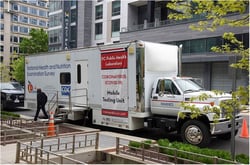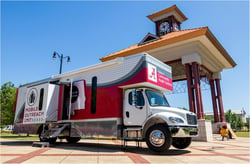For decades mobile clinics are a relatively untapped resource for global healthcare. In 2020 and beyond, the COVID-19 pandemic exhibits the important role of mobile health clinic programs. They provide critical access to healthcare professionals, especially for disenfranchised communities. They serve to fill the gap as a safety-net in what is often a deficient healthcare infrastructure, reaching social and economically underserved populations in urban and rural areas.
In spite of the unique value of this highly adaptable model of care, mobile clinics are often not supported throughout the healthcare community. The result is an overlooked opportunity to utilize mobile clinics during international emergencies such as the COVID-19 pandemic.
Adaptability of Mobile Clinics
The adaptability of mobile clinics makes them ideal for responding to a public health crisis such as the COVID pandemic. Some manufactures have taken important steps to ensure the health and safety of patients and staff inside a mobile health clinic while operating during this health crisis. A mobile clinic can be perceived as a fearful environment due to its confines. However to address these concerns advancements have been made in developing several methods to protect the public and medical staff while inside a mobile clinic, including:
and staff inside a mobile health clinic while operating during this health crisis. A mobile clinic can be perceived as a fearful environment due to its confines. However to address these concerns advancements have been made in developing several methods to protect the public and medical staff while inside a mobile clinic, including:
- Improving air quality with any one of:
- UV-C light duct kits inside the HVAC system automatically circulates the air past the hidden UV light which can reduce or prevent microorganisms from circulating within the ductwork of a confined space.
- On-Wall Add-On HEPA-UV-C units are self-contained and simply plug into the wall like any small appliance. The unit traps airborne droplets through a series of filters, including a high-intensity UV-C germicidal lamp which neutralizes and reduces airborne mold, bacteria and viruses.
- A Far-UVC recessed overhead ceiling light that is illuminated during or in between patient visits. Far-ultraviolet-C light has the correct energy to break apart organic molecular bonds. As harmful germs and tiny organisms pass through the far-UVC light their molecular structure is broken down with genetic damage which prevents them from reproducing.
- Provide social distancing by partitioning the inside of the mobile clinic and setting six foot spacing outside for patent safety.
An existing mobile health clinic that is a made as a mobile medical, dental or other service can be easily retrofitted with these safeguards. Plus, they can then be reworked in the future back to their original use. LifeLine Mobile is able to make these adjustments more easily and economically than those made by other companies.
New mobile clinics can be built specifically for COVID testing and screenings, and standard medical procedures. Once an immunization is discovered these clinics can be prepared to be the first on the front lines to administer inoculations. If required these specially designed clinics can then be reworked to a specific future use such as mobile dental, medical, mammography or other specialized service.
Longevity of Mobile Health Clinics
Commercial-grade mobile clinics are often still on the road after 25 years. Many institutions even have their units refurbished after 15 to 20 years for continued safe use. On the other hand, many manufactures  construct residential-grade vehicles that are converted RVs or buses, often using cheap box store furnishings which look great for a year or two but never last. Instead building on rugged chassis with a solid framework undercarriage composed of 4 inch steel I-beam cross members that run under the full length of the vehicle and incorporate commercial-grade furnishings, doors, flooring, and walls a mobile unit will have a significantly longer service life, and provide a safer and more secure environment. Plus, commercial-grade clinics provide a continuity of the healthcare institutions’ respected brand and image.
construct residential-grade vehicles that are converted RVs or buses, often using cheap box store furnishings which look great for a year or two but never last. Instead building on rugged chassis with a solid framework undercarriage composed of 4 inch steel I-beam cross members that run under the full length of the vehicle and incorporate commercial-grade furnishings, doors, flooring, and walls a mobile unit will have a significantly longer service life, and provide a safer and more secure environment. Plus, commercial-grade clinics provide a continuity of the healthcare institutions’ respected brand and image.
Cases in Point
Community Health Center of Niagara
The Community Health Center of Niagara has put a mobile COVID-19 diagnostic testing unit into operation for Niagara County, New York. This mobile unit is providing weekly diagnostic COVID-19 testing.
Clement Kwakye, Community Health Center of Niagara Site Director, said their “. . . goal is to help contain the spread of COVID-19 by giving diagnostic test access to many who may have transportation or underlying health issues and who otherwise may not have been able to get a diagnosis until it was too late.”
The University of Alabama’s Medical Center
The University of Alabama’s University Medical Center has teamed up with Alabama Power and Livingston, Georgia Mayor Tom Tartt to help provide COVID-19 screenings in Western Alabama’s  rural communities.
rural communities.
According to Dr. Richard Friend, Dean of UA’s College of Community Health Sciences; “Providing screenings in the Black Belt region of Alabama is important because there is limited access to health care in these communities. The numbers that we’ve seen demonstrate a low level of testing in these areas, so it is critical that we get resources to residents.” UA’s College of Community Health Sciences is hoping to expand COVID-19 screenings into other rural communities as more testing becomes available.
Funding
CareSouth Carolina in collaboration with the state health department has prepared for testing and response to the pandemic. They obtained federal funding of $140,000 to purchase retrofitted mobile clinics for testing that they plan to continue to use to keep vaccines cold and ready to deliver to residents when they become available.
In May of 2020 the U.S. Department of Health and Human Services (HHS) through the Health Resources and Services Administration (HRSA) provided $225 million to Rural Health Clinics for COVID-19 testing. This funding supports over 4,500 RHCs in the U.S. for providing COVID-19 testing efforts and expands access to testing in rural communities. Rural Health Clinics are a special designation given to health care practices in underserved rural areas by the Centers for Medicare and Medicaid Services that help ensure access to care for rural residents.
Even though mobile clinic operations are able to adapt quickly in a crisis, many programs are struggling to sustain or build upon their operations. Traditionally the largest source of funding for mobile clinics is philanthropy and healthcare institutions and community based health services need additional support to respond to this crisis. Historically funding comes from university medical schools, private corporations and organizations such as Ronald McDonald House Charities.
On a state level, the California HealthCare Foundation is an independent philanthropy committed to improving the way health care is delivered and financed in in the state. By promoting innovations and broader access to care they work to ensure all Californians have access to the care they need. The Foundation website is designed to assist applicants and grantees by providing guidelines, answers to frequently asked questions and related forms.
Conclusion - Are We Ready?
In the early stages of the COVID-19 crisis in the U.S. 121 mobile programs were surveyed and only 19 percent reported they are providing their usual services of care. This signifies a significant loss of important health and wellness programs limiting access of care in at-risk communities. Only 10 percent of these programs are providing testing to patients in response to the pandemic. For instance, a federally qualified health clinic in Austin, Texas is conducting outdoor testing where nurses prioritize patients in their vehicles, not on the mobile clinic. Qualified patients drive through the parking lot to be tested by a doctor. In another example Parkland Health and Hospital System in Dallas is using their seven mobile clinics to provide either drive-through COVID-19 testing or triage locations in the parking lots near their emergency departments or at regional off-site locations.
Hospitals, community health districts and public health departments have been struggling just to test and trace everyone exposed to the novel coronavirus. Yet as of early August many news organizations, including the Associated Press, have reported that the Federal Centers for Disease Control and Prevention instructed the healthcare community to be prepared to administer, distribute and track COVID-19 vaccinations as early as November 1, 2020.
In a four-page memo the Centers for Disease Control and Prevention told health departments across the country to draft vaccination plans by October 1 “to coincide with the earliest possible release of Covid-19 vaccine.” The CDC’s director, Dr. Robert Redfield, also wrote to governors about the urgent need for expediting the process to have vaccine distribution sites up and running by November 1st. Is this realistic? Most health departments have been significantly underfunded for decades and many claim they currently lack the staff, money and tools to educate people about vaccines and then to distribute them as they become available. And they do not know when, or if, they’ll get federal aid they need.
“There is a tremendous amount of work to be done to be prepared for this vaccination program and it will not be complete by November 1,” said Dr. Kelly Moore, associate director of immunization education at the Immunization Action Coalition, a national vaccine education and advocacy organization based in St. Paul, Minnesota. “States will need more financial resources than they have now.”
There is also the concern of reaching some of the hardest hit in underserved urban populations. Understandably the fastest and most efficient delivery model are mobile health clinics, which when properly equipped with clean air filtration and social distancing barriers can begin to prepare to serve on the front lines in delivering the cure.
Additional Sources Include:
- S. National Library of Medicine/National Institute of Health
- S. Department of Health and Human Services
- Progressive Charlestown
- Associated Press
- Scientific American
DISCLAIMER: Lifeline Mobile, Inc. does not assume any liability for the consequences arising out of the application, use, or misuse of any products contained in this communication including any injury and/or damage to any person or property as a matter of product liability, negligence, or otherwise. Nothing in this blog post should be construed as advice on the treatment of any disease. This information should not be considered final and is not a substitute for the advice of professional health care providers.


